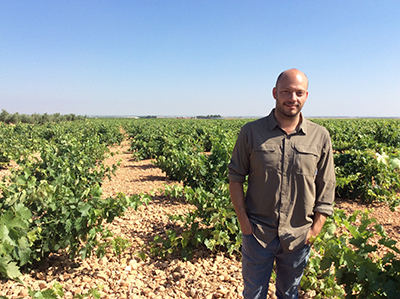
Elías López Montero set in motion a small revolution in Castilla-La Mancha with his work with the much-maligned local white grape Airén and other varieties that are well adapted to the climate of Spain’s southern plateau. Yet, Verum is pretty much on its own in Tomelloso, a village devoted to distillation and large volumes and home to Europe’s largest cooperative.
His family in fact owns Altosa, a leading exporter of grape spirit, and Verum occupies a small space withing its large facilities benefitting from the huge underground cellar where spirits are aged. Wine and spirits have been at the centre of this family business since the patriarch José López de la Fuente established the company in 1788, but in the 1990s the focus turned primarily to spirits. The youngest of four children, Elías trained as a winemaker and gained experience in South Africa and Ribera del Duero before he launched Verum in the mid 2000s.
His first wines were made from Tempranillo and international grape varieties that were widely planted in Castilla-La Mancha during the years of vineyard conversion financed with EU subsidies. These varieties are mostly grown in Los Arcángeles, a 40-hectare property with shallow, limestone soils and are destined to produced Verum’s classic range (about 250,000 bottles). It comprises three whites: a Malvasía Aromática and a blend of Gewürztraminer and Verdejo, both under €7 in Spain, and a €13 barrel- fermented Sauvignon Blanc aged for four months in striking cube-shaped barrels that the López Montero family first used for their spirits. The Verum reds include several varietal wines: Merlot (Vendimia Seleccionada, €21), Cabernet Franc (Reserva, €18) and two Tempranillos, Selección de Parcelas (€7.5) and Reserva Familiar (€20), a wine that is released after extended bottle aging.
The wines that have earned Verum international recognition are made from Airén and late ripening, rustic, drought-resistant varieties like Garnacha, Cariñena, Graciano, Albillo Real or the indigenous Tinto Velasco. The choice of grapes considered several studies conducted by the IVICAM, Castilla-La Mancha’s Vine and Wine Research Center.
The white Las Tinadas (6,500 bottles, €15) has radically changed the perception of Airén. Grapes are sourced from the family’s oldest, ungrafted vineyards planted in 1950 on stony soils. These creeping vines form a perfect umbrella-shaped canopy that protects grapes from the sun. Using natural yeasts and eschewing extrinsic aromas, López Montero produces an unctuous wine with moderate alcohol (12.5% abv.), depth and lovely briny notes leading to a long finish. It is aged in tinaja (clay jars) for four months.
Following the success of Las Tinadas, two more Airén whites have been released, retailing at around €15. Whereas La Divina comes from sandy-loam and limestone soils at 640 m elevation, Madrigal is sourced from a gentle slope at 720 m elevation, with deep sandy soils on calcareous rock. In both cases, fermentation begins in stainless steel tanks before being transferred to local old tinajas, where the wine remains for about three months before being aged on the lees in stainless steel tanks. Neutral, less aromatic grapes can be excellent at expressing the soils and vintage conditions.
Another new release starting in the 2016 vintage is the red Las Tinadas (7,000 bottles, €25). It is made from vines planted in the eponymous site in the 1960s and aged in tinaja for a whole year. The nose evokes the region’s distinctive, sun-drenched character (plum, meaty notes, firewood) but the palate is nicely textured, with good acidity and fine tannins. These grapes were formerly destined to the Reserva Familiar, which will now be produced from the oldest Tempranillo grapes in the Los Arcángeles vineyard.
With similar soils to Los Arcángeles and 40 hectares under vine, Finca Romeral features grape varieties which are expected to cope with climate change. They are destined to the Ulterior (beyond, in Spanish) range of wines. The grape variety and plot number each wine is sourced from is printed on the label. These wines are fully or partially aged in tinajas, traditional large clay jars with a capacity of 4,500 to 5,500 litres, some of which have been recovered from the ancient family winery and other bodegas in the region. Working in a distillery allows to efficiently clean them with grape spirits.
The Ulterior range includes just one white wine that develops beautifully with time. It is an Albillo Real co-fermented with some 14% of Albillo Mayor (6,000 bottles). Reds are more varied and include Cariñena (labelled Mazuelo, as the variety is known in Rioja), Graciano, Garnacha and Tinto Velasco.
The Garnacha, which is solely aged in tinaja, has a changing profile (riper in 2017 but wonderfully spicy, juicy and ethereal, almost Gredos-like in the fresh 2018 vintage). The Mazuelo is more powerful since it is aged entirely in oak, while the Graciano (with just 20% oak) offers a firm, juicy and spicy profile. The original, slightly rustic Tinto Velasco (50% in oak) is also fresh and expressive. All these wines retail at €19 in Spain. Production ranges from 6,000 to 8,000 bottles.
There is also a new Ulterior orange wine (€12, 5,000 bottles) that blends Albillo Mayor with 15% directly pressed Moravia Agria with two months of skin-contact.
Both ranges are organic certified since 2013 and, as a general rule, wines are fermented with natural yeasts. The wines are sold as VT Castilla. Tours are available by appointment and visitors are given the chance to explore both the winery and the distillery.
Montero also makes wines in Patagonia (Argentina) together with Hans Vinding-Diers, a cousin of Ribera del Duero’s Danish star Peter Sisseck. He has also started a small project in Rioja that includes two wines so far: a Tempranillo from San Vicente de la Sonsierra and a Garnacha from Cordovín.
Most popular
NEWSLETTER
Join our community of Spanish wine lovers


